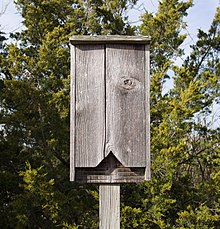
The yellow-billed magpie(Pica nuttalli), also known as the California magpie, is a large corvid that inhabits California's Central Valley and the adjacent chaparral foothills and mountains. Apart from its having a yellow bill and a yellow streak around the eye, it is virtually identical to the black-billed magpie (Pica hudsonia) found in much of the rest of North America. The scientific name commemorates the English naturalist Thomas Nuttall.
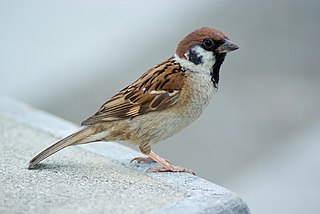
The Eurasian tree sparrow is a passerine bird in the sparrow family with a rich chestnut crown and nape and a black patch on each pure white cheek. The sexes are similarly plumaged, and young birds are a duller version of the adult. This sparrow breeds over most of temperate Eurasia and Southeast Asia, where it is known as the tree sparrow, and it has been introduced elsewhere including the United States, where it is known as the Eurasian tree sparrow or German sparrow to differentiate it from the native unrelated American tree sparrow. Although several subspecies are recognised, the appearance of this bird varies little across its extensive range.

Woodpeckers are part of the bird family Picidae, which also includes the piculets, wrynecks and sapsuckers. Members of this family are found worldwide, except for Australia, New Guinea, New Zealand, Madagascar and the extreme polar regions. Most species live in forests or woodland habitats, although a few species are known that live in treeless areas, such as rocky hillsides and deserts, and the Gila woodpecker specialises in exploiting cacti.

The glossy ibis is a water bird in the order Pelecaniformes and the ibis and spoonbill family Threskiornithidae. The scientific name derives from Ancient Greek plegados and Latin, falcis, both meaning "sickle" and referring to the distinctive shape of the bill.
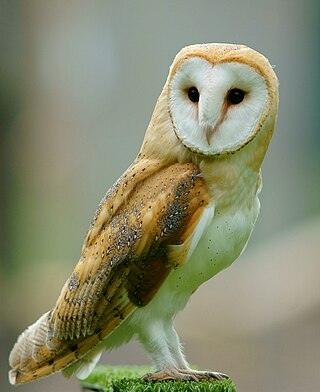
The barn owl is the most widely distributed species of owl in the world and one of the most widespread of all species of birds, being found almost everywhere except for polar and desert regions, Asia north of the Himalayas, some islands of Indonesia, and some Pacific Islands. It is also known as the common barn owl, to distinguish it from the other species in its family, Tytonidae, which forms one of the two main lineages of living owls, the other being the typical owls (Strigidae).
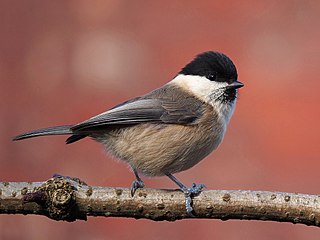
The willow tit is a passerine bird in the tit family, Paridae. It is a widespread and common resident breeder throughout temperate and subarctic Europe and across the Palearctic. The plumage is grey-brown and off-white with a black cap and bib. It is more of a conifer specialist than the closely related marsh tit, which explains it breeding much further north. It is resident, and most birds do not migrate.

The red-bellied woodpecker is a medium-sized woodpecker of the family Picidae. It breeds mainly in the eastern United States, ranging as far south as Florida and as far north as Canada. Though it has a vivid orange-red crown and nape it is not to be confused with the red-headed woodpecker, a separate species of woodpecker in the same genus with an entirely red head and neck that sports a solid black back and white belly. The red-bellied earns its name from the pale reddish blush of its lower underside.

The roseate tern is a species of tern in the family Laridae. The genus name Sterna is derived from Old English "stearn", "tern", and the specific dougallii refers to Scottish physician and collector Dr Peter McDougall (1777–1814). "Roseate" refers to the bird's pink breast in breeding plumage.

The white-breasted nuthatch is a species of bird in the nuthatch family Sittidae. It is a medium-sized nuthatch, measuring approximately 15.5 cm (6.1 in) in length. Coloration varies somewhat along the species' range, but the upperparts are light blue-gray, with a black crown and nape in males, while females have a dark gray crown. The underparts are whitish, with a reddish tinge on the lower abdomen. Despite not being closely related, the white-breasted nuthatch and the white wagtail are very similar in plumage. The white-breasted nuthatch is a noisy bird. It has a nasal voice and often utters little cries or vocalizations, often composed of repetitions of small invariant whistles. In summer, it is an exclusively insectivorous bird, consuming a wide range of arthropods, but in winter its diet consists mainly of seeds. The nest is located in the cavity of a tree. The clutch consists of five to nine eggs, incubated for two weeks by the female, who is fed by the male. The two adults then feed the young until they fledge, and for a few weeks after that.

The black-capped chickadee is a small, nonmigratory, North American passerine bird that lives in deciduous and mixed forests. It is a member of the Paridae family, also known as tits. It has a distinct black cap on its head, a black bib underneath, and white cheeks. It has a white belly, buff sides, and grey wings, back, and tail. The bird is well known for its vocalizations, including its fee-bee call and its chick-a-dee-dee-dee call, from which it derives its name.
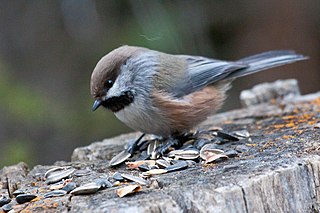
The boreal chickadee is a small passerine songbird in the tit family Paridae. It is found in the boreal forests of Alaska, Canada and the northern United States and remains within this range all year. This bird is known for its high pitched trill patterns used in communication with other birds and food storage habits in preparation for winter months.

The common myna or Indian myna, sometimes spelled mynah, is a bird in the family Sturnidae, native to Asia. An omnivorous open woodland bird with a strong territorial instinct, the common myna has adapted extremely well to urban environments.

The red-cockaded woodpecker is a woodpecker endemic to the southeastern United States. It is a federally endangered species under the Endangered Species Act of 1973.

A bird nest is the spot in which a bird lays and incubates its eggs and raises its young. Although the term popularly refers to a specific structure made by the bird itself—such as the grassy cup nest of the American robin or Eurasian blackbird, or the elaborately woven hanging nest of the Montezuma oropendola or the village weaver—that is too restrictive a definition. For some species, a nest is simply a shallow depression made in sand; for others, it is the knot-hole left by a broken branch, a burrow dug into the ground, a chamber drilled into a tree, an enormous rotting pile of vegetation and earth, a shelf made of dried saliva or a mud dome with an entrance tunnel. The smallest bird nests are those of some hummingbirds, tiny cups which can be a mere 2 cm (0.8 in) across and 2–3 cm (0.8–1.2 in) high. At the other extreme, some nest mounds built by the dusky scrubfowl measure more than 11 m (36 ft) in diameter and stand nearly 5 m (16 ft) tall. The study of birds' nests is known as caliology.

The oak titmouse is a passerine bird in the tit family Paridae. The American Ornithologists' Union split the plain titmouse into the oak titmouse and the juniper titmouse in 1996, due to distinct differences in song, preferred habitat, and genetic makeup.

A tree hollow or tree hole is a semi-enclosed cavity which has naturally formed in the trunk or branch of a tree. They are found mainly in old trees, whether living or not. Hollows form in many species of trees, and are a prominent feature of natural forests and woodlands, and act as a resource or habitat for a number of vertebrate and invertebrate animals.

A bird colony is a large congregation of individuals of one or more species of bird that nest or roost in proximity at a particular location. Many kinds of birds are known to congregate in groups of varying size; a congregation of nesting birds is called a breeding colony. Colonial nesting birds include seabirds such as auks and albatrosses; wetland species such as herons; and a few passerines such as weaverbirds, certain blackbirds, and some swallows. A group of birds congregating for rest is called a communal roost. Evidence of colonial nesting has been found in non-neornithine birds (Enantiornithes), in sediments from the Late Cretaceous (Maastrichtian) of Romania.

The purple martin is a passerine bird in the swallow family Hirundinidae. It is the largest swallow in North America. Despite its name, the purple martin is not truly purple. The dark blackish-blue feathers have an iridescent sheen caused by the diffraction of incident light giving them a bright blue to navy blue or deep purple appearance. In some light, they may even appear green in color.

The eastern barn owl is usually considered a subspecies group and together with the American barn owl group, the western barn owl group, and sometimes the Andaman masked owl make up the barn owl. The cosmopolitan barn owl is recognized by most taxonomic authorities. A few separate them into distinct species, as is done here. The eastern barn owl is native to southeastern Asia and Australasia.

The American barn owl is usually considered a subspecies group and together with the western barn owl group, the eastern barn owl group, and sometimes the Andaman masked owl, make up the barn owl, cosmopolitan in range. The barn owl is recognized by most taxonomic authorities. A few separate them into distinct species, as is done here. The American barn owl is native to North and South America, and has been introduced to Hawaii.

